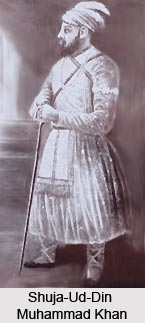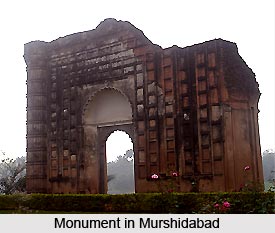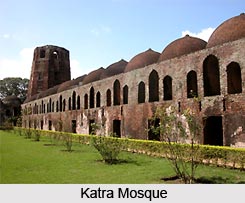 Shuja- Ud- Din Muhammad Khan was married to Zainab -Un- Nisa Begum, the daughter of Murshid Quli Khan who was the first Nawab of Bengal. After the death of Murshid Quli Khan on 27th June 1727, Shuja- Ud –Din ascended the throne and thus became the second Nawab of Bengal. Shuja-ud-Din is remembered as the most successful Nawab of Bengal who ushered in a reign of "rare" affluence in Bengal, in the 18th century. He was endowed with experience and tactic to handle a vast array of circumstances which was a policy he learned well from his father in law. Under his reign there began an era of secularism in Bengal as important position was given to the Hindus.
Shuja- Ud- Din Muhammad Khan was married to Zainab -Un- Nisa Begum, the daughter of Murshid Quli Khan who was the first Nawab of Bengal. After the death of Murshid Quli Khan on 27th June 1727, Shuja- Ud –Din ascended the throne and thus became the second Nawab of Bengal. Shuja-ud-Din is remembered as the most successful Nawab of Bengal who ushered in a reign of "rare" affluence in Bengal, in the 18th century. He was endowed with experience and tactic to handle a vast array of circumstances which was a policy he learned well from his father in law. Under his reign there began an era of secularism in Bengal as important position was given to the Hindus.
Early life of Shuja- Ud- Din Muhammad Khan
Shuja- Ud- Din Muhammad Khan was the son of Nawab Jan Muhammad Khan and was born in Burhanpur in Deccan. He was appointed as the Subahdar of Orissa in the year 1719 and as the governor of Bengal and Orissa in July 1727. In 1731 he became the Subahdar of Bihar. He received the title of Subahdar from the Mughal emperor of Delhi.
 Shuja- Ud- Din Muhammad Khan"s Rise to Power:
Shuja- Ud- Din Muhammad Khan"s Rise to Power:
Murshid Quli Khan did not have a direct heir so he nominated his maternal grandson Sarfaraz Khan as the Masnad of Bengal. At that time Shuja- Ud- Din Muhammad Khan was the Subahdar of Orissa and Alivardi Khan was his deputy. Murshid Quli Khan was not pleased with the friendly policies that Shuja- Ud- Din adopted and thus bestowed the responsibility of Bengal on his grand son Sarfaraz Khan. But Shuja- Ud- Din was not quite pleased with the idea of being employed under his son. With encouragement from Alivardi Khan and his brother Haji Ahmed, Shuja- Ud- Din decided to take over the throne of his father in law. He also sought permission and support from Mughal Emperor Muhammad Shah in Delhi, who readily agreed to help him. He made all due preparations and three days after Murshid Quli Khan"s death Shuja- Ud- Din enthroned himself as the Nawab. Alivardi Khan supported him with his army. With further support from Murshid Quli Khan"s wife Dowager Begum, Shuja- Ud- Din Muhammad Khan ascended the throne as the Masnad of Bengal and by August, 1727 Shuja-ud-Din Muhammad Khan was resolutely recognised as the Nawab of Bengal. In favour of the support meted out to him, Shuja- Ud- Din sent a huge sum of money from his revenue collection to the Mughal Emperor Muhammad Shah.
Administration of Shuja- Ud- Din Muhammad Khan
Shuja- Ud- Din Muhammad Khan was a brave man and a liberal administrator. He would always patiently hear of the disputes among his subjects and resolve them judiciously. Under his reign he uprooted from his kingdom the fundamentals of oppressions and tyrannies. His administrative policies were starkly different from that of his father in law, Murshid Quli Khan. Out of his despise towards Murshid Quli Khan"s policies he went to the level of auctioning the domestic goods of Murshid Quli Khan to the Hindu Zamindars who were his arch enemies. He destroyed most of the buildings built by Murshid Quli Khan and constructed newer and superior mansions in their place. He permitted the expansion and affluence of his subordinates who respected and gave him faithful services in return. Unlike his father in law, he was not feared and never extracted loyalty but rather commanded the same.
 In the year 1733 Shuja- Ud- Din amalgamated the Bihar Subah with Bengal and divided the merged territory into four administrative divisions namely, the central division which comprised west Bengal, north Bengal and central Bengal, the Dhaka division that consists of South and East Bengal, a small part of North Bengal and the districts of Chittagong and Sylhet, Orissa and Bihar. Shuja- Ud- Din assisted by the council of ministers administered the central divisions. He made few changes in the system of administration such as his son Sarfaraz Khan was made the Diwan of the Subah of Bengal, Haji Ahmad the brother of Alivardi Khan became his chief counselor, and his son in law Mirza Lutfullah was made the deputy Nazim of Dhaka.
In the year 1733 Shuja- Ud- Din amalgamated the Bihar Subah with Bengal and divided the merged territory into four administrative divisions namely, the central division which comprised west Bengal, north Bengal and central Bengal, the Dhaka division that consists of South and East Bengal, a small part of North Bengal and the districts of Chittagong and Sylhet, Orissa and Bihar. Shuja- Ud- Din assisted by the council of ministers administered the central divisions. He made few changes in the system of administration such as his son Sarfaraz Khan was made the Diwan of the Subah of Bengal, Haji Ahmad the brother of Alivardi Khan became his chief counselor, and his son in law Mirza Lutfullah was made the deputy Nazim of Dhaka.
The administrative measures of Shuja- Ud- Din Muhammad Khan included the re settlements of deprived Hindu Zamindars who were kept in confinement, and tormented by Murshid Quli Khan. After firmly establishing his government, Shuja- Ud- Din released such Zamindars and other landholders as he found on enquiry free from offense or fraud. This act of his earned him huge popularity and immense profit. Shuja-ud-Din Muhammad Khan inherited a packed treasury from Murshid Quli Khan and he utilised this wealth in public welfare. The eminent buildings built by him are a majestic Palace, an Arsenal, a lofty Gateway, Revenue Court, a Private Office, a Public Audience Hall, a Boudoir for Ladies, a Court of Exchequer, a Reception Hall and a Court of Justice. He attended always to the well-being of his Army, and to the contentment of his subjects.
Shuja- Ud- Din Muhammad Khan died in the year 1739 of natural causes and left behind two sons and two daughters. He was buried in Roshnibag in Murshidabad. He was succeeded by his son Sarfaraz Khan. Shuja-ud-Din left behind a very affluent and prosperous Bengal in the hands of his son and the Nasiri dynasty ended in another thirteen months with Sarfaraz Khan.






